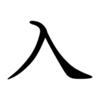入
| ||||||||
Translingual
| Stroke order | |||
|---|---|---|---|
 | |||
Han character
入 (radical 11, 入+0, 2 strokes, cangjie input 人竹 (OH), four-corner 80000, composition ⿹乀丿)
- Kangxi radical #11, ⼊.
Derived characters
- Index:Chinese radical/入
References
- KangXi: page 125, character 32
- Dai Kanwa Jiten: character 1415
- Dae Jaweon: page 266, character 18
- Hanyu Da Zidian: volume 1, page 102, character 1
- Unihan data for U+5165
Chinese
| simp. and trad. |
入 | |
|---|---|---|
Glyph origin
| Historical forms of the character 入 | ||||||||||||||||||||||||||||||||||||||||||||||||||||||||||||||||||||||||||||||||||||||||||||||||||||||||||||||||||||||||||||||||
|---|---|---|---|---|---|---|---|---|---|---|---|---|---|---|---|---|---|---|---|---|---|---|---|---|---|---|---|---|---|---|---|---|---|---|---|---|---|---|---|---|---|---|---|---|---|---|---|---|---|---|---|---|---|---|---|---|---|---|---|---|---|---|---|---|---|---|---|---|---|---|---|---|---|---|---|---|---|---|---|---|---|---|---|---|---|---|---|---|---|---|---|---|---|---|---|---|---|---|---|---|---|---|---|---|---|---|---|---|---|---|---|---|---|---|---|---|---|---|---|---|---|---|---|---|---|---|---|---|
| Shang | Western Zhou | Warring States | Shuowen Jiezi (compiled in Han) | Liushutong (compiled in Ming) | ||||||||||||||||||||||||||||||||||||||||||||||||||||||||||||||||||||||||||||||||||||||||||||||||||||||||||||||||||||||||||||
| Oracle bone script | Bronze inscriptions | Chu Slip and silk script | Small seal script | Transcribed ancient scripts | ||||||||||||||||||||||||||||||||||||||||||||||||||||||||||||||||||||||||||||||||||||||||||||||||||||||||||||||||||||||||||||
 |
 |
 |
 |
 | ||||||||||||||||||||||||||||||||||||||||||||||||||||||||||||||||||||||||||||||||||||||||||||||||||||||||||||||||||||||||||||
| ||||||||||||||||||||||||||||||||||||||||||||||||||||||||||||||||||||||||||||||||||||||||||||||||||||||||||||||||||||||||||||||||
|
References: Mostly from Richard Sears' Chinese Etymology site (authorisation),
| ||||||||||||||||||||||||||||||||||||||||||||||||||||||||||||||||||||||||||||||||||||||||||||||||||||||||||||||||||||||||||||||||
Ideogram (指事) - an arrowhead indicating "to enter".
Compare 人 (rén).
Etymology
From Proto-Sino-Tibetan *nup ~ nip. Cognate with Tibetan ནུབ (nub, “to fall (gradually), sink, to set; to decay, to decline”) and Burmese နိပ် (nip, “to decline (e.g. price); to be suppressed, to settle, to be quelled”).
Chinese characters belonging to the same word family include:
- 納 (OC *nuːb, “to make enter”)
- 內 (OC *nuːbs, “inside”)
- 軜 (OC *nuːb, “reins on the inside of the horse”)
- 妠 (OC *nuːms, *nuːb, *rnoːd, “to marry (a girl)”)
- and potentially Cantonese 擸 (laap3, “to bring together, to collect”)
The regular Mandarin pronunciation as predicted from Middle Chinese is rì. The irregular sound change is for taboo reasons - to avoid homophony with its derived vulgar meaning "to enter > to have sexual intercourse", nowadays represented by 日 (rì).
Pronunciation
Definitions
入
- to enter; to go into
- to join; to become a member of
- to accept; to admit
- to pay
- income
- to confirm; to agree
- to conform (to)
- to arrive (at); to attain
- to go to imperial court
- to invade
- (telephony) to get through
- Synonyms: 通 (tōng)
- (Cantonese) inside
- (dialectal Mandarin, dialectal Wu, vulgar) to fuck; to have sexual intercourse
- Short for 入聲/入声 (rùshēng, “the checked tone”).
Compounds
|
|
|
Japanese
Readings
- Go-on: にゅう (nyū, Jōyō)←にふ (nifu, historical)
- Kan-on: じゅう (jū)←じふ (zifu, historical)
- Kan’yō-on: じゅ (ju); にっ (ni')←にふ (nifu, historical)
- Kun: いる (iru, 入る, Jōyō); いり (iri, 入り); いれる (ireru, 入れる, Jōyō); はいる (hairu, 入る, Jōyō)←はひる (fafiru, historical)
- Nanori: いり (iri); いる (iru); しお (shio); しほ (shiho); なり (nari)
Compounds
- 圧入 (atsunyū)
- 移入 (inyū)
- 介入 (kainyū)
- 加入 (kanyū)
- 陥入 (kannyū)
- 観入 (kannyū)
- 嵌入 (kannyū)
- 貫入 (kannyū)
- 記入 (kinyū)
- 吸入 (kyūnyū)
- 工具入 (kōguire)
- 購入 (kōnyū)
- 混入 (konnyū)
- 悟入 (gonyū)
- 塵入 (gomiire)
- 歳入 (sainyū)
- 算入 (sannyū)
- 参入 (sannyū)
- 四捨五入 (shisha gonyū)
- 収入 (shūnyū)
- 出入 (shutsunyū)
- 新入 (shinnyū)
- 侵入 (shinnyū)
- 進入 (shinnyū)
- 浸入 (shinnyū)
- 切入 (setsunyū)
- 先入 (sennyū)
- 潜入 (sennyū)
- 挿入 (sōnyū)
- 単刀直入 (tantōchokunyū)
- 代入 (dainyū)
- 注入 (chūnyū)
- 闖入 (chinnyū)
- 転入 (tennyū)
- 投入 (tōnyū)
- 突入 (totsunyū)
- 導入 (dōnyū)
- 納入 (nōnyū)
- 搬入 (hannyū)
- 場所入 (bashoiri)
- 一入 (hitoshio)
- 平上去入 (hyōjōkyonyū)
- 封入 (fūnyū)
- 編入 (hennyū)
- 没入 (botsunyū)
- 申入 (mōshiire)
- 輸入 (yunyū)
- 濫入 (rannyū)
- 乱入 (rannyū)
- 流入 (ryūnyū)
- 弯入 (wannyū)
- 彎入 (wannyū)
- 湾入 (wannyū)
- 押入 (oshiire)
- 婿入 (mukoiri)
- 入会 (nyūkai)
- 立入禁止 (tachiirikinshi)
- 入口 (iriguchi)
- 入江 (irie)
- 嫁入道中 (yomeiridōchū)
- 入日 (irihi)
- 入母屋 (irimoya)
- 入婿 (irimuko)
- 入り目 (irime)
- 入墨 (irezumi)
- 入院 (nyūin)
- 入営 (nyūei)
- 入園 (nyūen)
- 入苑 (nyūen)
- 入荷 (nyūka)
- 入海 (iriumi)
- 入閣 (nyūkaku)
- 入学 (nyūgaku)
- 入掛 (irekake)
- 入棺 (nyūkan)
- 入監 (nyūkan)
- 入居 (nyūkyo)
- 入渠 (nyūkyo)
- 入漁 (nyūgyo)
- 入京 (nyūkyō)
- 入境 (nyūkyō)
- 入金 (nyūkin)
- 入庫 (nyūko)
- 入御 (nyūgo)
- 入交 (irimajiri)
- 入坑 (nyūkō)
- 入校 (nyūkō)
- 入港 (nyūkō)
- 入稿 (nyūkō)
- 入貢 (nyūkō)
- 入国 (nyūkoku)
- 入獄 (nyūgoku)
- 入魂 (nyūkon)
- 入札 (nyūsatsu)
- 入試 (nyūshi)
- 入歯 (ireba)
- 入室 (nyūshitsu)
- 入質 (nyūshichi)
- 入舎 (nyūsha)
- 入射 (nyūsha)
- 入社 (nyūsha)
- 入寂 (nyūjaku)
- 入手 (nyūshu)
- 入塾 (nyūjuku)
- 入所 (nyūsho)
- 入賞 (nyūshō)
- 入城 (nyūjō)
- 入場 (nyūjō)
- 入植 (nyūshoku)
- 入神 (nyūshin), 入伸 (nyūshin)
- 入信 (nyūshin)
- 入水 (jusui), 入水 (nyūsui)
- 入声 (nisshō)
- 入籍 (nyūseki)
- 入船 (nyūsen), 入船 (irifune), 入船 (Irifune)
- 入選 (nyūsen)
- 入相 (iriai)
- 入隊 (nyūtai)
- 入団 (nyūdan)
- 入朝 (nyūchō)
- 入超 (nyūchō)
- 入津 (nyūshin)
- 入定 (nyūjō)
- 入廷 (nyūtai)
- 入電 (nyūden)
- 入党 (nyūtō)
- 入唐 (nittō)
- 入湯 (nyūtō)
- 入道 (nyūdō)
- 入内 (judai)
- 入念 (nyūnen)
- 入梅 (tsuyuiri), 入梅 (nyūbai)
- 入費 (nyūhi)
- 入夫 (nyūfu)
- 入府 (nyūfu)
- 入部 (nyūbu)
- 入仏 (nyūbutsu)
- 入物 (iremono)
- 入幕 (nyūmaku)
- 入滅 (nyūmetsu)
- 入綿 (irewata)
- 入木 (nyūboku)
- 入門 (nyūmon)
- 入用 (nyūyō)
- 入浴 (nyūyoku)
- 入来 (nyūrai)
- 入洛 (juraku), 入洛 (nyūraku)
- 入力 (nyūryoku)
- 入牢 (nyūrō)
- 入冦 (nyūkō)
- 入寇 (nyūkō)
- 入鋏 (nyūkyō)
Korean
Vietnamese
Han character
入: Hán Việt readings: nhập[1][2][3]
入: Nôm readings: nhập[2][3], nhạp[3][4], nhấp[1], nhắp[1], vào[1], nhép[3], nhẹp[3]
References
- Nguyễn (2014).
- Nguyễn et al. (2009).
- Trần (2004).
- Hồ (1976).


























































































































